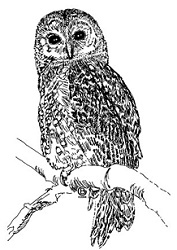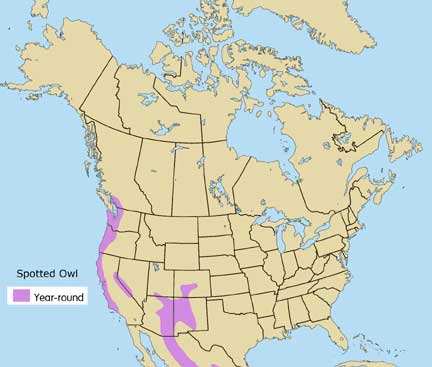
Scientific Name: Strix occidentalis caurina
This owl lives in the deep forests of the Pacific Northwest, with camouflage feathering to blend with patterns of dim light filtering through tree branches. Like the related Barred Owl, this species has a stocky body, short tail, and broad wings; the sexes are similar, but the female is generally larger. The large head is rounded and lacks ear tufts; a facial disc with a feather pattern of concentric barring surrounds large, dark brown eyes. The head and upper parts are dark brown, irregularly spotted and speckled with white. The under parts are dark brown and buff, with large, white, rounded spots, and barring across the belly. The Northern Spotted Owl can be distinguished from the Barred Owl in its darker color, smaller size, lack of streaking on the belly, darker face, and greenish, horn-colored bill. Fledglings of the Northern Spotted Owl have a narrower pattern of bands on the wings than fledglings of its relative.
Male/Female
Length: 17.5″ ave.
Wingspan: 40″ ave.
Weight: 1.3 lb. ave.
State and federally protected; listed as Threatened under the Endangered Species Act.
The Northern Spotted Owl lives in mature to old-growth coniferous forests and typically requires large territories. Avoids open areas, where it is vulnerable to predation by the Great Horned Owl; has been found nesting in managed stands of second-growth redwoods, where the growth of shoots from redwood stumps creates excellent habitat for wood rats, which have become the favored prey of the Spotted Owl in that habitat.
Small mammals, primarily rodents, are the major part of the diet. The Northern Flying Squirrel is the single most important prey species. This nocturnal to semi-nocturnal owl is an opportunistic hunter, and will also take birds, fish, reptiles, amphibians, and insects. The most common hunting technique is diving down on prey from an elevated perch.
The call most often heard is a four or five note, barking call of whoooo…oowho,oowhooo. Resembles the Barred Owl call, but higher in pitch and a shorter series of notes.
Almost all Northern Spotted Owl nests are found in old-growth conifers near water. About 65% of nests are found in tree cavities or the broken top of trees where branches have grown up to cover the old top, and 35% of nests are moss platforms on horizontal branches or stick constructions, usually built by other species.
Collisions with vehicles. Destruction and fragmentation of habitat from logging, and degrading of habitat through policies of even-aged tree management are the major threat to this species.

Southwest British Columbia, south to central California in the Cascades and Coast Ranges. Decreasing in number and range due to logging of old-growth forests, and the resulting fragmentation and destruction of habitat. In areas where this species overlaps with the expanding range of the more aggressive Barred Owl, this smaller owl is at a disadvantage in competing for food or territory.
Special Thanks for range maps:
Dan Gleason
BGleason Design & Illustration
Commercial & Scientific Illustration, Graphic Design
CraneDance Communications
Book Production/Design

